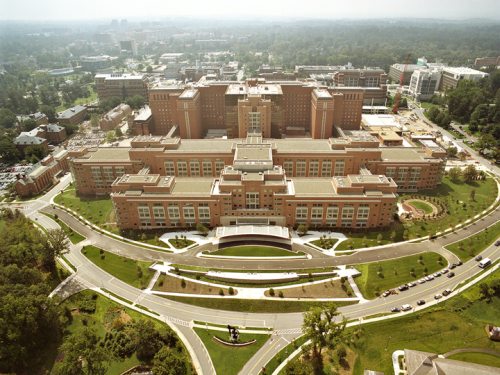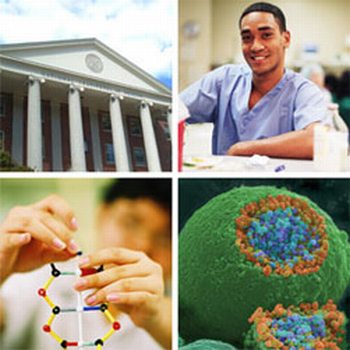National Institutes of Health (NIH). Information.
National Institutes of Health (NIH)
part of the U.S. Department of Health and Human Services (HHS).

About National Institutes of Health (NIH).
The National Institutes of Health (NIH), a part of the U.S. Department of Health and Human Services ![]() , is the nation’s medical research agency—making important discoveries that improve health and save lives.
, is the nation’s medical research agency—making important discoveries that improve health and save lives.
Thanks in large part to NIH-funded medical research, Americans today are living longer and healthier. Life expectancy in the United States has jumped from 47 years in 1900 to 78 years as reported in 2009, and disability in people over age 65 has dropped dramatically in the past 3 decades. In recent years, nationwide rates of new diagnoses and deaths from all cancers combined have fallen significantly.


> National Institutes of Health (NIH). Scientific Leadership
NIH is the largest source of funding for medical research in the world, creating hundreds of thousands of high-quality jobs by funding thousands of scientists in universities and research institutions in every state across America and around the globe.
NIH is made up of 27 Institutes and Centers, each with a specific research agenda, often focusing on particular diseases or body systems. NIH leadership plays an active role in shaping the agency’s research planning, activities, and outlook.
The Office of the Director is the central office at NIH, responsible for setting policy for NIH and for planning, managing, and coordinating the programs and activities of all the NIH components. The NIH Director, with a unique and critical perspective on the entire agency, is responsible for providing leadership to the Institutes and for constantly identifying needs and opportunities, especially for efforts that involve multiple Institutes. The NIH Director is assisted by the NIH Deputy Directors including the Principal Deputy Director, who shares in the overall direction of the agency’s activities.
NIH is responsive to Congressional legislation that adjusts NIH’s programs to meet changing research needs. As a result of the NIH reauthorization process, NIH is able to respond strategically in an era when medical research requires constant innovation and increased interdisciplinary efforts.
More than 80% of the NIH’s budget goes to more than 300,000 research personnel at over 3,000 universities and research institutions. In addition, about 6,000 scientists work in NIH’s own Intramural Research laboratories, most of which are on the NIH main campus in Bethesda, Maryland. The main campus is also home to the NIH Clinical Center, the largest hospital in the world totally dedicated to clinical research.
Successful biomedical research depends on the talent and dedication of the scientific workforce. NIH supports many innovative training programs and funding mechanisms that foster scientific creativity and exploration. The goal is to strengthen our nation’s research capacity, broaden our research base, and inspire a passion for science in current and future generations of researchers.
NIH encourages and depends on public involvement in federally supported research and activities. NIH’s wide-ranging public efforts include outreach and education, nationwide events, requests for public input on NIH projects, and special programs designed specifically to involve public representatives in clinical research.
> National Institutes of Health (NIH). A History of Health

For over a century, NIH scientists have paved the way for important discoveries that improve health and save lives. In fact, more than 130 Nobel Prize winners have received support from NIH. Their studies have led to the development of MRI, understanding of how viruses can cause cancer, insights into cholesterol control, and knowledge of how our brain processes visual information, among dozens of other advances.

National Institutes of Health (NIH). Mission
NIH’s mission is to seek fundamental knowledge about the nature and behavior of living systems and the application of that knowledge to enhance health, lengthen life, and reduce the burdens of illness and disability.

The goals of the agency are:
- to foster fundamental creative discoveries, innovative research strategies, and their applications as a basis for ultimately protecting and improving health;
- to develop, maintain, and renew scientific human and physical resources that will ensure the Nation’s capability to prevent disease;
- to expand the knowledge base in medical and associated sciences in order to enhance the Nation’s economic well-being and ensure a continued high return on the public investment in research; and
- to exemplify and promote the highest level of scientific integrity, public accountability, and social responsibility in the conduct of science.
In realizing these goals, the NIH provides leadership and direction to programs designed to improve the health of the Nation by conducting and supporting research:
- in the causes, diagnosis, prevention, and cure of human diseases;
- in the processes of human growth and development;
- in the biological effects of environmental contaminants;
- in the understanding of mental, addictive and physical disorders; and
- in directing programs for the collection, dissemination, and exchange of information in medicine and health, including the development and support of medical libraries and the training of medical librarians and other health information specialists.

> National Institutes of Health (NIH). NIH Organization
The National Institutes of Health is made up of 27 different components called Institutes and Centers. Each has its own specific research agenda. All but three of these components receive their funding directly from Congress, and administrate their own budgets.
The Office of the Director is the central office, responsible for setting policy for NIH and for planning, managing, and coordinating the programs and activities of all the NIH components.
>> Institutes, Centers & Offices.
NIH is made up of 27 Institutes and Centers, each with a specific research agenda, often focusing on particular diseases or body systems. NIH leadership plays an active role in shaping the agency’s activities and outlook
>> NIH Institutes.
NCI leads a national effort to eliminate the suffering and death due to cancer. Through basic and clinical biomedical research and training, NCI conducts and supports research that will lead to a future in which we can prevent cancer before it starts, identify cancers that do develop at the earliest stage, eliminate cancers through innovative treatment interventions, and biologically control those cancers that we cannot eliminate so they become manageable, chronic diseases. More about NCI
NEI conducts and supports research that helps prevent and treat eye diseases and other disorders of vision. This research leads to sight-saving treatments, reduces visual impairment and blindness, and improves the quality of life for people of all ages. NEI-supported research has advanced our knowledge of how the eye functions in health and disease. More about NEI

NHLBI provides leadership for a national program in diseases of the heart, blood vessels, lung, and blood; blood resources; and sleep disorders. Since October 1997, the NHLBI has also had administrative responsibility for the NIH Woman’s Health Initiative. The Institute plans, conducts, fosters, and supports an integrated and coordinated program of basic research, clinical investigations and trials, observational studies, and demonstration and education projects. More about NHLBI

NHGRI is devoted to advancing health through genome research. The Institute led NIH’s contribution to the Human Genome Project, which was successfully completed in 2003 ahead of schedule and under budget. Building on the foundation laid by the sequencing of the human genome, NHGRI’s work now encompasses a broad range of research aimed at expanding understanding of human biology and improving human health. In addition, a critical part of NHGRI’s mission continues to be the study of the ethical, legal and social implications of genome research. More about NHGRI
NIA leads a national program of research on the biomedical, social, and behavioral aspects of the aging process; the prevention of age-related diseases and disabilities; and the promotion of a better quality of life for all older Americans. More about NIA
NIAAA conducts research focused on improving the treatment and prevention of alcoholism and alcohol-related problems to reduce the enormous health, social, and economic consequences of this disease. More about NIAAA
NIAID research strives to understand, treat, and ultimately prevent the myriad infectious, immunologic, and allergic diseases that threaten millions of human lives. More about NIAID
NIAMS supports research into the causes, treatment, and prevention of arthritis and musculoskeletal and skin diseases, the training of basic and clinical scientists to carry out this research, and the dissemination of information on research progress in these diseases. More about NIAMS

National Institute of Biomedical Imaging and Bioengineering (NIBIB) — Est. 2000
NIBIB improves health by promoting fundamental discoveries, design and development, and translation and assessment of technological capabilities in biomedical imaging and bioengineering, enabled by relevant areas of information science, physics, chemistry, mathematics, materials science, and computer sciences. More about NIBIB
Eunice Kennedy Shriver National Institute of Child Health and Human Development (NICHD) — Est. 1962
NICHD research on fertility, pregnancy, growth, development, and medical rehabilitation strives to ensure that every child is born healthy and wanted and grows up free from disease and disability. More about NICHD
NIDCD conducts and supports biomedical research and research training on normal mechanisms as well as diseases and disorders of hearing, balance, smell, taste, voice, speech, and language that affect 46 million Americans. More about NIDCD
NIDCR provides leadership for a national research program designed to understand, treat, and ultimately prevent the infectious and inherited craniofacial-oral-dental diseases and disorders that compromise millions of human lives. More about NIDCR
NIDDK conducts and supports basic and applied research and provides leadership for a national program in diabetes, endocrinology, and metabolic diseases; digestive diseases and nutrition; and kidney, urologic, and hematologic diseases. Several of these diseases are among the leading causes of disability and death; all seriously affect the quality of life of those who have them. More about NIDDK
NIDA leads the nation in bringing the power of science to bear on drug abuse and addiction through support and conduct of research across a broad range of disciplines and rapid and effective dissemination of research results to improve prevention and treatment and to inform policy as it relates to drug abuse and addiction. More about NIDA
NIEHS reduces the burden of human illness and dysfunction from environmental causes by, defining how environmental exposures, genetic susceptibility, and age interact to affect an individual’s health. More about NIEHS

National Institute of General Medical Sciences (NIGMS) — Est. 1962
NIGMS supports basic biomedical research that is not targeted to specific diseases. NIGMS funds studies on genes, proteins, and cells, as well as on fundamental processes like communication within and between cells, how our bodies use energy, and how we respond to medicines. The results of this research increase our understanding of life and lay the foundation for advances in disease diagnosis, treatment, and prevention. NIGMS also supports research training programs that produce the next generation of biomedical scientists, and it has special programs to encourage underrepresented minorities to pursue biomedical research careers. More about NIGMS
NIMH provides national leadership dedicated to understanding, treating, and preventing mental illnesses through basic research on the brain and behavior, and through clinical, epidemiological, and services research. More about NIMH
The mission of NIMHD is to promote minority health and to lead, coordinate, support, and assess the NIH effort to reduce and ultimately eliminate health disparities. In this effort NIMHD will conduct and support basic, clinical, social, and behavioral research, promote research infrastructure and training, foster emerging programs, disseminate information, and reach out to minority and other health disparity communities. More about NIMHD
The mission of the NINDS is to reduce the burden of neurological disease—a burden borne by every age group, every segment of society, and people all over the world. To accomplish this goal the NINDS supports and conducts basic, translational, and clinical research on the normal and diseased nervous system. The Institute also fosters the training of investigators in the basic and clinical neurosciences, and seeks better understanding, diagnosis, treatment, and prevention of neurological disorders. More about NINDS
National Institute of Nursing Research (NINR) — Est. 1986
NINR supports clinical and basic research to establish a scientific basis for the care of individuals across the life span—from the management of patients during illness and recovery to the reduction of risks for disease and disability; the promotion of healthy lifestyles; the promotion of quality of life in those with chronic illness; and the care for individuals at the end of life. This research may also include families within a community context, and it also focuses on the special needs of at-risk and under-served populations, with an emphasis on health disparities. More about NINR
NLM collects, organizes, and makes available biomedical science information to scientists, health professionals, and the public. The Library’s Web-based databases, including PubMed/Medline and MedlinePlus, are used extensively around the world. NLM conducts and supports research in biomedical communications; creates information resources for molecular biology, biotechnology, toxicology, and environmental health; and provides grant and contract support for training, medical library resources, and biomedical informatics and communications research. More about NLM
>> NIH Centers
CIT incorporates the power of modern computers into the biomedical programs and administrative procedures of the NIH by focusing on three primary activities: conducting computational biosciences research, developing computer systems, and providing computer facilities. More about CIT
The Center for Scientific Review (CSR) is the portal for NIH grant applications and their review for scientific merit. CSR organizes the peer review groups or study sections that evaluate the majority (70%) of the research grant applications sent to NIH. CSR also receives all grant applications for NIH, as well as for some other components of the U.S. Department of Health and Human Services (DHHS). Since 1946, the CSR mission has remained clear and timely: to see that NIH grant applications receive fair, independent, expert, and timely reviews — free from inappropriate influences — so NIH can fund the most promising research. More about CSR
FIC promotes and supports scientific research and training internationally to reduce disparities in global health. More about FIC
NCCAM is dedicated to exploring complementary and alternative medical (CAM) practices in the context of rigorous science; training CAM researchers and disseminating authoritative information. More about NCCAM
NCRR provides laboratory scientists and clinical researchers with the tools and training they need to understand, detect, treat and prevent a wide range of diseases. NCRR supports all aspects of clinical and translational research, connecting researchers, patients and communities across the nation. This support enables discoveries made at a molecular and cellular level to move to animal-based studies, and then to patient-oriented clinical research, ultimately leading to improved patient care. More about NCRR
CC is the clinical research facility of the National Institutes of Health. As a national resource, it provides the patient care, services, and environment needed to initiate and support the highest quality conduct of and training in clinical research. More about CC

> National Institutes of Health (NIH). NIH Leadership
>> NIH Director Francis S. Co.llins, M.D., Ph.D.
On August 17, 2009, Dr. Francis S. Collins became the Director of the National Institutes of Health.

The NIH Director plays an active role in shaping the agency’s activities and outlook. With a unique and critical perspective on the whole of the NIH, the Director is responsible for providing leadership to the Institutes and for constantly identifying needs and opportunities, especially for efforts that involve multiple Institutes.
Lawrence A. Tabak, D.D.S., Ph.D.—Principal Deputy Director, NIH
Kathy Hudson, Ph.D.—Deputy Director for Science, Outreach, and Policy
Michael Gottesman, M.D.—Deputy Director for Intramural Research
Sally J. Rockey, Ph.D.—Deputy Director for Extramural Research
Colleen Barros, M.A.—Deputy Director for Management and Chief Financial Officer
James M. Anderson, M.D., Ph.D.—Deputy Director for Program Coordination, Planning, and Strategic Initiatives
>> Institute and Center Directors
Each NIH Institute and Center has its own director to lead the pursuit of the research mission specific to the Institute.
>> The Role of the NIH Director
The NIH Director plays an active role in shaping the agency’s activities and outlook. With a unique and critical perspective on the whole of the NIH, the Director is responsible for providing leadership to the Institutes and for constantly identifying needs and opportunities, especially for efforts that involve multiple Institutes.
The Director stays in touch with each Institute’s priorities and accomplishments through:
- regular senior staff meetings,
- discussions with scientific interest groups, and
- briefing sessions with Institute directors.
The Director also seeks advice from an appointed group of public representatives and the Council of Councils, a special panel of experts convened to advise the NIH Director on matters related to the policies and activities of the Division of Program Coordination, Planning and Strategic Initiatives. In addition to this flow of information from scientists, the Director is advised through discussions with the Administration, usually through the Department of Health and Human Services ![]() (HHS), and with the Congress.
(HHS), and with the Congress.
The NIH Director is responsible for advising the President on his annual budget request to Congress on the basis of extensive discussions with the Institute Directors.

> National Institutes of Health (NIH). NIH Budget. Research for the People
The NIH invests over $31.2* billion annually in medical research for the American people.
More than 80% of the NIH’s funding is awarded through almost 50,000 competitive grants to more than 325,000 researchers at over 3,000 universities, medical schools, and other research institutions in every state and around the world.
About 10% of the NIH’s budget supports projects conducted by nearly 6,000 scientists in its own laboratories, most of which are on the NIH campus in Bethesda, Maryland.


> National Institutes of Health (NIH). Location
Headquarters for the Office of the Director and the Institutes and Centers are located in Bethesda, Maryland, USA. NIH has more than 75 buildings in a campus-like environment over 300 acres. Some research is performed on campus in state-of-the-art laboratory facilities, although more than 80% of research activities are conducted by scientists working in every state and around the world.


* This amount excludes the $10 billion appropriated to NIH in 2009 for short-term stimulus purposes under the American Recovery & Reinvestment Act (ARRA) available for obligation across a two-year timeframe until September 30, 2010.






















